首都医科大学外科学(普外科)2019年考博真题考博试卷
- 格式:doc
- 大小:41.00 KB
- 文档页数:2
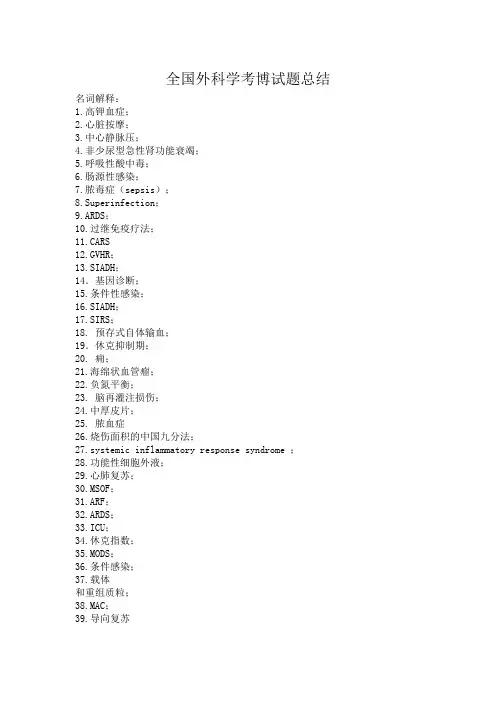
全国外科学考博试题总结名词解释:1.高钾血症;2.心脏按摩;3.中心静脉压;4.非少尿型急性肾功能衰竭;5.呼吸性酸中毒;6.肠源性感染;7.脓毒症(sepsis);8.Superinfection;9.ARDS;10.过继免疫疗法;11.CARS12.GVHR;13.SIADH;14.基因诊断;15.条件性感染;16.SIADH;17.SIRS;18. 预存式自体输血;19.休克抑制期;20. 痈;21.海绵状血管瘤;22.负氮平衡;23. 脑再灌注损伤;24.中厚皮片;25. 脓血症26.烧伤面积的中国九分法;27.systemic inflammatory response syndrome ;28.功能性细胞外液;29.心肺复苏;30.MSOF;31.ARF;32.ARDS;33.ICU;34.休克指数;35.MODS;36.条件感染;37.载体和重组质粒;38.MAC;39.导向复苏40.精准医疗论述题:1、较广泛的或剧烈的创伤性炎症对机体可引起哪些不利影响?(10 分)2、成人呼吸窘迫综合症的临床表现和分期(15 分)。
3.输血适应症4.外科抗菌药应用原则5.理想手术切口应具备的条件6.肾替代疗法应达到的指标7.DIC 的临床表现8.创伤治愈的分期、处理原则9.理想的肿瘤标志物应具备的特点10. 肾在体内酸碱平衡调节的机制11. 肠外营养的适应证和并发症12. 自体输血的方式和禁忌证13.试述肠内营养适应证14.试述自体输血的适应证与禁忌症15.分输血的种类和适应症16.肠源性感染的发病机制17.代谢性酸中毒的分型及常见原因18.创伤的检查与诊断步骤(13)19.脑复苏的现代观念及主要方法20.灭菌与消毒有何区别?21.高钾血症的原因和诊断处理?22.肠外营养有哪些常见并发症如何处理23.简述外科如何选择和使用抗菌药物?24..创伤后组织修复分几个阶段?简述其修复过程?25.创伤后组织修复过程分为哪几个阶段?各阶段的主要特点是什么?26.试述肿瘤浸润与转移过程中的相关因素?27.试述创伤的代谢变化及其临床意义?28.溶血反应的发病机理及病理变化?29.感染性休克病理生理变化过程中血流动力学改变有何特征?治疗要点是什么?30.全胃肠外营养的并发症31..肠细菌移位的发生机制32.腹部外科术后心力衰竭的紧急处理,应从哪些方面着手?33.有哪些腹部外科疾病与病毒感染有关?如何预防和治疗。
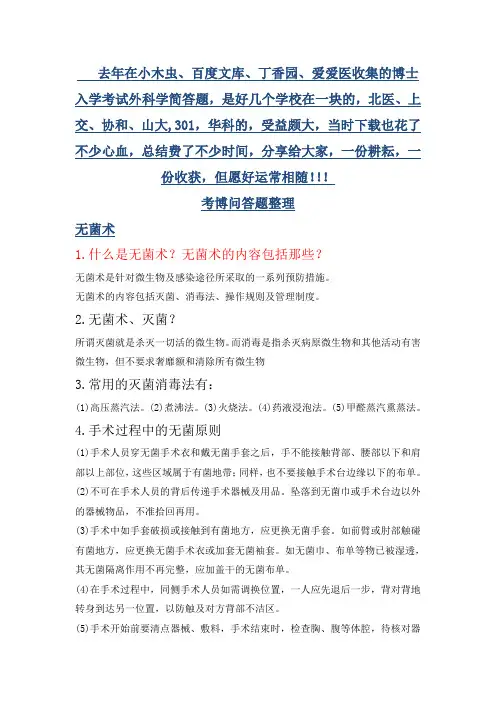
去年在小木虫、百度文库、丁香园、爱爱医收集的博士入学考试外科学简答题,是好几个学校在一块的,北医、上交、协和、山大,301,华科的,受益颇大,当时下载也花了不少心血,总结费了不少时间,分享给大家,一份耕耘,一份收获,但愿好运常相随!!!考博问答题整理无菌术1.什么是无菌术?无菌术的内容包括那些?无菌术是针对微生物及感染途径所采取的一系列预防措施。
无菌术的内容包括灭菌、消毒法、操作规则及管理制度。
2.无菌术、灭菌?所谓灭菌就是杀灭一切活的微生物。
而消毒是指杀灭病原微生物和其他活动有害微生物,但不要求奢靡额和清除所有微生物3.常用的灭菌消毒法有:(1)高压蒸汽法。
(2)煮沸法。
(3)火烧法。
(4)药液浸泡法。
(5)甲醛蒸汽熏蒸法。
4.手术过程中的无菌原则(1)手术人员穿无菌手术衣和戴无菌手套之后,手不能接触背部、腰部以下和肩部以上部位,这些区域属于有菌地带;同样,也不要接触手术台边缘以下的布单。
(2)不可在手术人员的背后传递手术器械及用品。
坠落到无菌巾或手术台边以外的器械物品,不准拾回再用。
(3)手术中如手套破损或接触到有菌地方,应更换无菌手套。
如前臂或肘部触碰有菌地方,应更换无菌手术衣或加套无菌袖套。
如无菌巾、布单等物已被湿透,其无菌隔离作用不再完整,应加盖干的无菌布单。
(4)在手术过程中,同侧手术人员如需调换位置,一人应先退后一步,背对背地转身到达另一位置,以防触及对方背部不洁区。
(5)手术开始前要清点器械、敷料,手术结束时,检查胸、腹等体腔,待核对器械、敷料数无误后,才能关闭切口,以免异物遗留腔内产生严重后果。
(6)切口边缘应以无菌大纱布垫或手术巾遮盖,并用巾钳或缝线固定,仅显露手术切口。
术前手术区粘贴无菌塑料薄膜可达到相同目的。
(7)做皮肤切口以及缝合皮肤之前,需再消毒皮肤一次。
(8)切开空腔脏器前,要先用纱布垫保护周围组织,以防止或减少污染。
(9)参观手术的人员不可太靠近手术人员或站得太高,也不可经常在室内走动,以减少污染的机会。
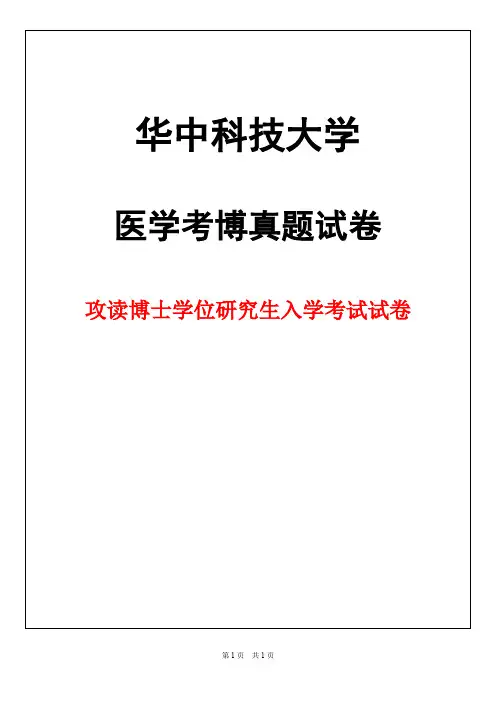
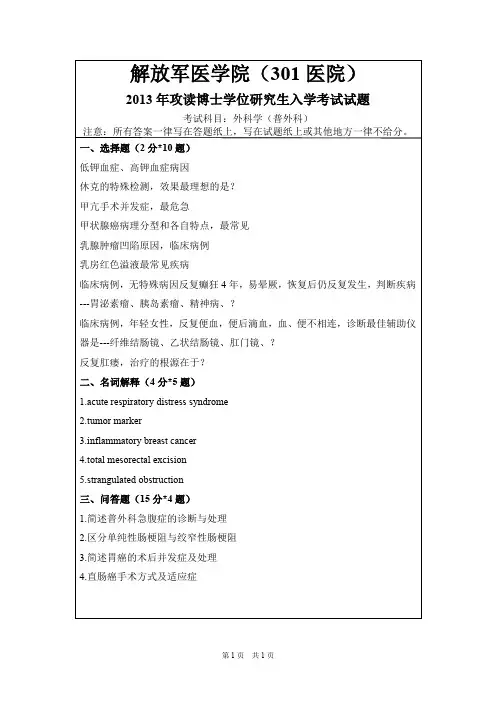
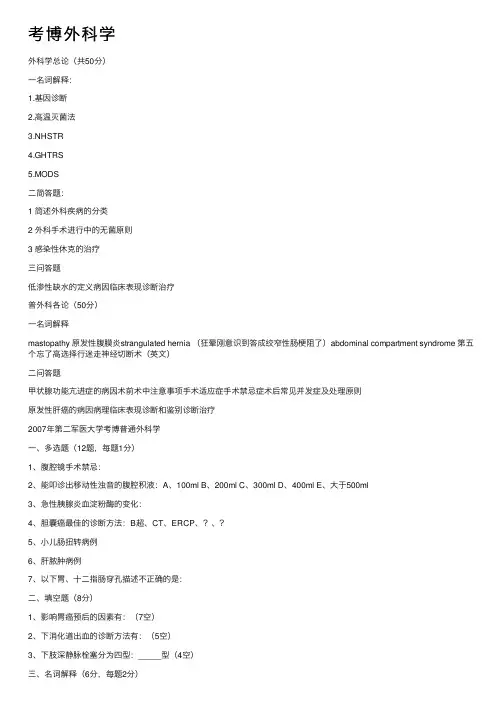
考博外科学外科学总论(共50分)⼀名词解释:1.基因诊断2.⾼温灭菌法3.NHSTR4.GHTRS5.MODS⼆简答题:1 简述外科疾病的分类2 外科⼿术进⾏中的⽆菌原则3 感染性休克的治疗三问答题低渗性缺⽔的定义病因临床表现诊断治疗普外科各论(50分)⼀名词解释mastopathy 原发性腹膜炎strangulated hernia (狂晕刚意识到答成绞窄性肠梗阻了)abdominal compartment syndrome 第五个忘了⾼选择⾏迷⾛神经切断术(英⽂)⼆问答题甲状腺功能亢进症的病因术前术中注意事项⼿术适应症⼿术禁忌症术后常见并发症及处理原则原发性肝癌的病因病理临床表现诊断和鉴别诊断治疗2007年第⼆军医⼤学考博普通外科学⼀、多选题(12题,每题1分)1、腹腔镜⼿术禁忌:2、能叩诊出移动性浊⾳的腹腔积液:A、100ml B、200ml C、300ml D、400ml E、⼤于500ml3、急性胰腺炎⾎淀粉酶的变化:4、胆囊癌最佳的诊断⽅法:B超、CT、ERCP、?、?5、⼩⼉肠扭转病例6、肝脓肿病例7、以下胃、⼗⼆指肠穿孔描述不正确的是:⼆、填空题(8分)1、影响胃癌预后的因素有:(7空)2、下消化道出⾎的诊断⽅法有:(5空)3、下肢深静脉栓塞分为四型:_____型(4空)三、名词解释(6分,每题2分)1、buerger病2、charcot 综合征3、TME四、问答题1、家族性结肠息⾁病的发病原理、诊断、⼿术⽅式、术后随访原则?(20分)2、甲亢术后并发症及处理?(24分)3、肠梗阻按梗阻原因的分类;肠梗阻的治疗原则以及⾮⼿术治疗⽅法?(30分)第三军医⼤学2013博⼠普外专业⼀、名词解释1、richer疝2、倾倒综合征(英⽂)3、布加综合征(英⽂)4、⼆、简答题1、乳腺癌根治术切除范围2、胰腺癌⼿术切除范围3、简述直肠癌超低位保肛术4、chiold分级及其临床意义三、问答题1、急性梗阻性黄疸治疗原则2、论述胃癌外科治疗的最新进展2013南京医科⼤学普外科学(总论+普外)考博真题回忆版简答4分*61、创伤组织修补基本过程?2、30秒内确定⼼搏骤停的⽅法?3、输⾎后常见并发症?4、低钾的常见病因?5、营养⽀持⽅法选择原则?6、⼿术中的⽆菌原则?问答19分*41、胰腺假性囊肿的⼿术指征、⽅式、要点?2、甲状腺⼿术并发症及治疗?3、腹膜后⼗⼆指肠破裂诊断依据及治疗?4、完善的科研设计标志有哪些?第三军医⼤学2013年外科专业基础之⼈体解剖真题名词解释:胸⾻⾓纵隔膜迷路动脉韧带肺段简答脑屏障的主要特点喉的结构,运动及功能的关系胆汁的产⽣,排出的主要特点问答⽪质核束的主要特点内脏传导通路的主要特点迷⾛神经的主要特点腰丛的主要特点2013中⼭⼤学博⼠⽣⼊学考试(普外)1糖⽪质激素外科感染性休克2糖尿病围术期准备要点3开放⽓胸处理原则4影像学在泌尿系结⽯的诊断应⽤5胃癌腹腔镜禁忌6胆管囊性扩张的分型7下肢静脉体格检查名称8外科真菌感染因素和抗真菌药物9切⼝裂开预防10⿊⾊素瘤的临床表现11CEA.AFP.CA199.CA125.PSA,中⽂名称及诊断价值12门脉⾼压⾮⼿术治疗及贲门⾎管离断理由13 低渗性缺⽔的原因14乳腺癌分⼦分型及治疗建议15胃癌根治原则,根治划分,远端胃癌根治切除范围16慢性胰腺炎⼿术指征,⼿术原则,⼿术⽅式。

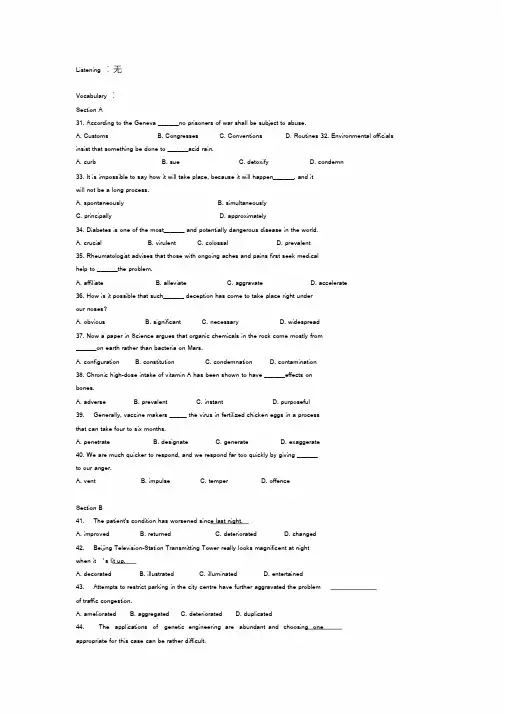
Listening :无Vocabulary :Section A31. According to the Geneva ______no prisoners of war shall be subject to abuse.A. CustomsB. CongressesC. ConventionsD. Routines 32. Environmental officials insist that something be done to ______acid rain.A. curbB. sueC. detoxifyD. condemn33. It is impossible to say how it will take place, because it will happen______, and itwill not be a long process.A. spontaneouslyB. simultaneouslyC. principallyD. approximately34. Diabetes is one of the most______ and potentially dangerous disease in the world.A. crucialB. virulentC. colossalD. prevalent35. Rheumatologist advises that those with ongoing aches and pains first seek medicalhelp to ______the problem.A. affiliateB. alleviateC. aggravateD. accelerate36. How is it possible that such______ deception has come to take place right underour noses?A. obviousB. significantC. necessaryD. widespread37. Now a paper in Science argues that organic chemicals in the rock come mostly from______on earth rather than bacteria on Mars.A. configurationB. constitutionC. condemnationD. contamination38. Chronic high-dose intake of vitamin A has been shown to have ______effects onbones.A. adverseB. prevalentC. instantD. purposeful39. Generally, vaccine makers _____ the virus in fertilized chicken eggs in a processthat can take four to six months.A. penetrateB. designateC. generateD. exaggerate40. We are much quicker to respond, and we respond far too quickly by giving ______to our anger.A. ventB. impulseC. temperD. offenceSection B41. The patient's condition has worsened since last night.A. improvedB. returnedC. deterioratedD. changed42. Beijing Television-Station Transmitting Tower really looks magnificent at nightwhen it ’s lit up.A. decoratedB. illustratedC. illuminatedD. entertained43. Attempts to restrict parking in the city centre have further aggravated the problemof traffic congestion.A. amelioratedB. aggregatedC. deterioratedD. duplicated44. The applications of genetic engineering are abundant and choosing oneappropriate for this case can be rather difficult.A. sufficientB. plentifulC. adequateD. countable45. The defect occurs in the first eight weeks of pregnancy, though no one understandswhy.A. deficitB. deviationC. draw backD. discrepancy46. He has been on hormone alternate therapy for four years and looks fantastic.A. successorB. replacementC. surrogateD. choice47. It had over 2,000 apartment complexes, a great market, a large number ofindustrial workshops, an administrative center, a number of massive religious edifices,and a regular grid pattern of streets and buildings.A. ancientB. carefullyC. very largeD. carefully protected48. When patients spend extended periods in hospital, they tend to become overlydependent and lose interest in taking care of themselves.A. extremelyB. exclusivelyC. exactlyD. explicitly49. The anxious parent was vigilant over the injured child in spite of a full array ofemergency room of doctors and nurses.A. preoccupiedB. unwaryC. watchfulD. dozing50. The doctor vacillated so frequently on disease-preventiontechniques that hiscolleagues accused him of inconsistency.A. waveredB. instigatedC. experimentedD. reliedClozeWe spend a lot of time looking at the eyes of others for social 51 —it helpsus understand a person ’emotions, and make decisions about how to respond to them. We also know that adults avoid eye contact when anxious. But researchers have knownfar 52 about eye gazing patterns in children.According to new research by Kalina Michalska, assistant professor of psychologyat the University of California, Riverside, we now, know that anxious children tend toavoid making eye contact, and this has consequences for how they experience fear. The53 and less frequently they look at the eyes of others, the more likely they are to beafraid of them, even when there may be no reason to be. Her study, “Anxiety Sympand Children's Eye Gaze During Fear Leaming”w,as published in the journal TheJournal of Child Psychology and Psychiatry."Looking at someone ’s eyes helps us understand whether a person is feeling sad, angry, fearful, or surprised. As adults, we then make decisions about how to respondand what to do next. But, we know much less about eye patterns in children —so,understanding those patterns can help us learn more about the development of sociallearning, ”Michalska said.Michalska and the team of researchersshowed 82 children, 9 to 13 years old,images of two women ’s faces on a computer screen. The computer was equipped withan eye tracking device that allowed them to measure54 on the screen children werelooking, and for how long. The participants were originally shown each of the twowomen a total of four times. Next, one of the images was55 with a loud scream anda fearful expression, and the other one was not. At the end, children saw both facesagain without any sound or scream.The following three conclusions can be drawn from the study:1. All children spent more time looking at the eyes of a face that was paired withthe loud scream t han the face that was not paired with the scream, 56 they payattention to potential threats even in the absence of outward cues.2. Children who were more anxious avoided eye contact during all three phases of the experiment, for both kinds of faces. This had consequences for how afraid they wereof the faces.3. The more children avoided eye conta;cthe more afraid they were 57 the faces.The conclusions suggest that children spend more time looking at the eyes of aface when previously paired with something frightening suggesting they pay moreattention to potentially threatening information as a way to learn more about thesituation and plan what to do next.However, anxious children tend to avoid making eye contact, which leads togreater 58 experience. Even though avoiding eye contact may reduce anxiety59 , the study finds that — over time — children may be m i s s6i n0g_ o i m u p t ortantsocial information. This includes that a person may no longer be threatening or scary,and yet the child continues feeling fearful of that person.51. A. environment B. cues C. relations D. answers52. A. less B. more C. enough D. beyond53. A. longer B. more anxious C. shorter D. more54. A. where B. when C. how D. what55. A. followed B. recorded C. paired D. marked56. A. suggest B. suggesting C. suggests D. being suggested57. A. to B. of C.at D. about58. A. fear B. surprise C. sad D. angry59. A. in the long run B. for a long timeC. in the short timeD. in a long time60. A. with B. without C. of D. onReading ComprehensionPassage OneThe British psychoanalyst John Bowlby maintains that separation from the parentsduring the sensitive “attachment p”e riod from birth to three may scar a child ’s personality and predispose to emotional problems in later life.Some people have drawn the conclusion from Bowlby' s work that children shouldnot be subjected to day care before the age of three because of the parental separationit entails, and many people do believe this. It has been argued that an infant under threewho is cared for outside the home may suffer because of the separation from his parents. But there are also arguments against such a strong conclusion.But traditional societies are so different from modem societies that comparisonsbased on just one factor are hard to interpret. Firstly, anthropologists point out that theinsulated love affair between children and parents found in modem societies does notusually exist in traditional societies. For example, in some tribal societies, such as theNgoni, the father and mother of a child did not rear their infant alone —far from i Certainty, Bowlby ’s analysis raises the possibilities that early day care had delayedeffects. The possibility that such care might lead to, say, more mental illness or crime15 or 20 years later can only explored by the use of statistics. However, statisticalstudies of this kind have not yet been carried out, and even if they were, the resultswould certainly be complicated and controversial. Secondly, common sense tells us that day care would not be so widespread today if parents, care-takers found children hadproblems with it. Thirdly, in the last decade, t here have been a number of careful American studies of children in day care, and they have uniformly reported that care had a neutral or slightly positive effect on children ’s development.Whatever the long-term effects, parents sometimes find the immediate effectsdifficult to deal with. Children under three are likely to protest at leaving their parentsand show unhappiness. At the age of three or three and a half almost all children findthe transition to nursery eas,yand this is undoubtedly why more and more parents make use of child care at this time. The matter, then, is far from clear-cut, though experienceand available evidence indicate early care is reasonable for infants.61. According to the passage, the consequence of parental separation________.A. still needs more statistical studiesB. has been found negative is more seriousC. is obviousD. in modem times62. The author thinks that John Bowlby ’s concern___________.A. is relevant and justifiableB. is too strong to RelieveC. is utterly groundlessD. has something that deserve our attention63. What ’s the result of American studies of children in day care in the last decade?A. The children ’s unhappiness and protest was due to the day care the children received.B. The bad effects of parental separation were hard to deal with.C. The effect of day care was not necessarily negative on children ’s development.D. Early care was reasonable for babies since it ’p sracti c ed by so many peoplenowadays.64. According to the passage, which of the following is probably a reason forparents to send their children under three to day care?A. They don ’t know about day care ’s negative effect.B. They are too busy to care fortheir children.C. They want their children to be independent as early as possible.D. They want to facilitate their children to adapt to nursery at the age of about three.65. What ’s the author ’s attitude to people who have drawn the conclusion fromBowlby’s work that children should not be subjected to day care before the age ofthree?A. He supports most of their belief because Bowlby's proposition is well-grounded.B. He is sympathetic for them, for he thinks they have been misled by Bowlby.C. He doesn't totally agree with them, since the long-term effect of day care still needsfurther study.D. He doesn't quite understand them, as they are contradictory in themselves.Passage TwoBy the end of this century, the average world temperature is expected to increasebetween one and four degrees, with widespread effects on rainfall, sea levels and animalhabitats. But in the Arctic, where the effects of climate change are most intense, the risein temperature could be twice as much.Understanding how Arctic warming will affect the people, animals, plant andmarine life and economic activity in Canada’N sort h are important to the country's future, says Kent Moore, an atmospheric physicist at University of Toronto Mississaugawho is participating in a long-term, international study of the marine ecosystem alongthe Beaufort Sea, from Alaska to the Mackenzie delta.The study will add to our knowledge of everything from the extent of sea ice inthe region to how fish stocks will change to which areas could become targets for oiland gas exploration to the impact on the indigenous people who call this part of thecountry home.Moore, who has worked in the Arctic for more than 20 years, says his research hasalready found that thinning sea ice and changes in wind patterns are causing animportant change in the marine food chain: phytoplankton(淳游植物) is blooming two to three weeks earlier. Manyanimals time their annual migration to the Arctic forwhen food is plentiful, and have not adapted to the earlier bloom. " ' Animals' behaviorcan evolve over a long time, but these climate changes are happening in the space of adecade, r ather than hundreds of years, ”says Moore, " Animals can't change theirbehavior that quickly. ”A warmer Arctic is expected to have important effects on human activity in theregion, as the Northwest Passage becomes navigable during the summer, and resourceextraction becomes more feasible. Information gained from the study will helpgovernment, industry and communities make decisions about resource management,economic development and environmental protection.Moore says the study — which involves Canadian, American and Europeanresearchersand government agencies will also use a novel technology to gatheratmospheric data: remotely piloted drones. "The drones have the capability of a largeresearch aircraft,and they ’re easier to deploy, ” he says, showing the researchers to gather information on a more regular basis than they would be able to with pilotedaircraft.66. By the end of this century, according to the author, global warming will ______.A. start to bring about extreme weather events to humans and animalsB. increase the average world temperature by four degreesC. cause more damages to the whole world than expectedD. affect the Arctic more than any other parts of the earth67. To help understand the destructive mechanism of Arctic warming, as indicatedby the passage, the international study ______.A. is conducted with every single discipline of University of TorontoB. pioneers in pursuing the widespread effects of climate changeC. involves so many countries for different investigationsD. is intended to deal with various aspects in research68. When he ways, “Animals can ’t change their behavior that quickly, ”what doesMoore mean by that quickly?A. The migration of the animals to the Arctic.B. The widespread effects of global warming.C. The rate of the climate change in the Arctic.D. The phytoplankton within the marine ecosystem.69. According to the author, to carry out proper human activities in theArctic______.A. becomes more difficult than ever beforeB. is likely to build a novel economy in the regionC. will surely lower the average world temperatureD. needs the research-based supporting information70. With the drones deployed, as Moore predicts, the researchers will _______.A. involve more collaborating countries than they do nowB. get more data to be required for their researchC. use more novel technologies in researchD. conduct their research at a regular basisPassage ThreeHaving too much caffeine during pregnancy may impair baby ’s liver development and increase the risk of liver disease in adulthood, according to a study published in theJournal of Endocrinology. Pregnant rats given caffeine had offspring with lower birth weights, altered growth and stress hormonelevels and impaired liver development. Thestudy findings indicate that consumption of caffeine equivalent to 2-3 cups of coffee may alter stress and growth hormone levels in a manner that can impair growth and development, and increase the risk of liver disease in adulthood.Previous studies have indicated that prenatal caffeine intake of 300 mg/day ormore in women, which is approximately 2 to 3 cups coffee per day, can result in lower birth weights of their children. Animalstudies have further suggestedthat prenatalcaffeine consumption may have more detrimental long-term effects on liverdevelopment with an increased susceptibility to non-alcoholic fatty liver disease, adebilitating condition normally associated w ith obesity and diabetes. However, theunderlying link between prenatal caffeine exposure and impaired liver developmentremains poorly understood. A better understanding of how caffeine mediates theseeffects could help prevent these health issues in people in the future.In this study, Prof Hui Wang and colleagues at Wuhan University in China,investigated the effects of low (equivalent to 2-3 cups of coffee) and high dose(equivalent of 6-9 cups of coffee) caffeine, given to pregnant rats, on liver function andhormone levels of their offspring. Offspring exposed to prenatal caffeine had lower levels of the liver hormone, insulin likegrowth factor (IGF-1), and higher levels of thestress hormone, corticosteroid at birth. However, liver development after birth showed a compensatory 'catch up' phase, characterised by increased levels of IGF-1, which is important for growth.Dr. Yinxian Wen, study co-author, says, “Our results indicate that prenatal caffeine causes an excess of stress hormone activity in the mother, which inhibits IGF-1 activityfor liver development before birth. However, compensatory mechanisms do occur after birth to accelerate growth and restore normalliver function, as IGF-1 activity increasesand stress hormone signalling decreases. The increased risk of fatty liver disease causedby prenatal caffeine exposure is most likely a consequence of this enhanced,compensatory postnatal IGF-1 activity. ”These findings not only confirm that prenatal caffeine exposure leads to lowerbirth weight and impaired liver development before birth but also expand our currentunderstanding of the hormonal changes underlying these changes and suggest thepotential mechanism for increased risk of liver disease in the future. However, theseanimal findings need to be confirmed in humans.Dr. Wen comments, "Our work suggeststhat prenatal caffeine is not good for babies and although these findingsstill need to be confirmed in people, I wouldrecommend that women avoid caffeine during pregnancy."71. Which of the following is NOT the problem of baby rats of pregnant rats givencaffeine?A. Lower birth weight.B. Smaller stress.C. Liver development problem.D. Growth problem.72. If a pregnant woman takes 3 cups of coffee, what will probably happen?A. Her weight will get lower and lower.B. The weight of her baby will get lower and lower.C. She will suffer from non-alcoholic fatty liver disease in a long run.D. Her baby will be more vulnerable to obesity and diabetes because of liver problem.73. Which of following is not correct according to the passage?A. A better understanding of the relationship between caffeine and effects has beenachieved.B. 4-5 cups of coffee could be categorized as medium-dose intake.C. Liver development problem may be remedied after birth by increased growth factor.D. The study is mainly conducted on the rats instead of human.74. What is the relationship between stress hormone and liver development whentaking in prenatal caffeine?A. Lower stress hormone, lower birth weight before birth.B. Higher stress hormone, lower growth hormone before birth.C. Higher stress hormone, more accelerated growth of weight after birth.D. Lower stress hormone, less accelerated growth of liver after birth.75. What can be the best summary of the last paragraph?A. The research hasn ’t been done on humans so pregnant women can ignore the results.B. The compensatory mechanism for liver growth makes prenatal caffeine intake safe.C. Experts suggest pregnant women should still avoid caffeine.D. We have known enough about the hormone changes underlying the healthPassage FourThe bizarre antics of sleepwalkers have puzzled police, perplexed scientists, and fascinated writers for centuries. There is an endless supply of stories about sleepwalkers.Persons have been said to climb on steep roofs, solve mathematical problems, composemusic, walk through plate-glass windows, and commit murder in their sleepHow many of these stories have a basis in fact, and how many are pure fakery?No one knows, but if some of the most sensational stories should be taken with a barrelof salt, others are a matter of record.In Revere, Massachusetts, a hundred policemen combed a waterfrontneighborhood for a lost boy who left his home in his sleep and woke up five hours lateron a strange sofa in a strange living room, with no idea how he had got there.There is an early medical record of a somnambulist who wrote a novel in his sleep.And the great French writer V oltaire knew a sleepwalker who once got out of bed,dressed himself, made a polite bow, danced a minuet, and then undressed and went backto bed.At the University of Iowa, a student was reported to have the habit of getting upin the middle of the night and walking three-quarters of a mile to the Iowa River. He would take a swim and then go back tohis room to bed.The world's champion sleepwalker was supposed to have been an Indian, PanditRamrakha, who walked sixteen miles along a dangerous road without realizing that hehad left his bed. Second in line for the title is probably either a Vienna housewife or a British farmer. The woman did all her shopping on busy streets in her sleep. The farmer,in his sleep, visited a veterinarian miles away.The leading expert on sleep in America claims that he has never seen a sleepwalker.He is Dr. Nathaniel Kleitman, a physiologist at the University of Chicago. He is said toknow more about sleep than any other living man, and during the last thirty-five yearshad lost a lot of sleep watching people sleep. Says he, "Of course, I know that there are sleepwalkers becauseI have read about them in the newspapers. B ut none of mysleepers ever walked, and if I were to advertise for sleepwalkers for an experiment, Idoubt that I'd get many takers."Sleepwalking, nevertheless, is a scientific reality. Like hypnosis, it is one of thosedramatic, eerie, awe-inspiring phenomena that sometimes border on the fantastic. Itlends itself to controversy and misconceptions, what is certain about sleepwalking isthat it is a symptom of emotional disturbance, and that the only way to cure it is to remove the worries and anxieties that cause it. Doctors say that somnambulism is muchmore common than is generally supposed.Some have estimated that there are fourmillion somnambulists in the United States. Others set the figure even higher. Manysleepwalkers do not seek help and so are never put on record, which means that anaccurate count can never be made.The simplest explanation of sleepwalking is that it is the acting out of a vividdream. The dream usually comes from guilt, worry, nervousness, o r some otheremotional conflict. The classic sleepwalker is Shakespeare ’L asdy Macbeth. Hernightly wanderings were caused by her guilty conscience at having committed murder. Shakespeare said of her, “The eyes are open but their sense is shut. ”The age-old question is: Is the sleepwalker actually awake or asleep. Scientists have decided that he is about half-and-half. Like Lady Macbeth, he has weightyproblems on his mind. Dr. Zeida Teplitz, who made a ten-year study of the subject, says, “Some people stay awake all night worrying about t heir problems. The sleepwalker thrashes them out in his sleep. He is awake in the muscular area, partially asleep in the sensory area." In other words, a person can walk in his sleep, move around, and do other things, but he does not think about what he is doing.76. The second sentence in the second paragraph means that_________.A. no one knows, but certainly all the sleep walking stories have something incredibleB. the sleepwalking stories are like salt adding flavor to people ’s lifeC. sleepwalking stories that are most fantastic should be sorted out from ordinary storiesD. the most fantastic sleepwalking stories may be just fictions, yet there are stilltruthfully recorded stories77. ________was supposed to be the world's champion sleepwalker.A. The student habitually walked to the Iowa River and swam in his sleepB. The man danced a minuet in his sleepC. The man walker sixteen miles along a dangerous roadD. The boy walked five hours in his sleep78. Sleepwalking is the result of ______ according to the passage.A. emotional disorderB. a vivid dreamC. lack of sleep and great anxietyD. insanity79. Dr. Zeida Teplitz seemed to_________.A. agree that sleepwalking sometimes leads to dangerous actsB. conclude that sleepwalkers are awake in their sensory areaC. disagree with the belief that sleep walkers are immune to injuryD. think that sleepwalking can turn into madness80. The writer makes it obvious that_________.A. sleepwalkers are often awakened by dangersB. most sleepwalkers can find ways to avoid self-injuryC. it is important to find out the underlying cause of sleepwalkingD. sleepwalking is actually a kind of hypnosisPassage FiveBeyond the basic animal instincts to seek food and avoid pain, Freud identifiedtwo sources of psychic energy, which he called "drives ”: aggression and libido. The keto his theory is that these were unconscious drives, shaping our behavior without themediation of our waking minds; they surface, heavily disguised, only in our dreams.The work of the past half-century in psychology and neuroscience has been to downplaythe role of unconscious universal drives, focusing instead on rational processesinconscious life. But researchers have found evidence that Freud s drives really do exist,and they have their roots in the limbic system, a primitive part of the brain that operatesmostly below the horizon of consciousness.Now more commonly referred to as emotions, the modem suite of drives comprises five: rage, panic, separation distress,lust and a variation on libido sometimes called seeking.The seeking drive is proving a particularly fruitful subject for researchers.Although like the others it originates in the limbic system, it also involves parts of theforebrain, the seat of higher mental functions. In the 1980s, Jaak Panksepp, aneurobiologist at Bowling Green State University in Ohio, became interested in a placenear the cortex known as the ventraltegmental area, which in humans lies just abovethe hairline. When Panksepp stimulated the corresponding region in a mouse, theanimal would sniff the air and walk around, as though it were looking for something.Was it hungry? No. The mouse would walk right by a plate of food, or for that matterany other object Panksepp could think of. This brain tissue seemed to cause a generaldesire for something new. “What I was seeing, ” he says, “was the urge to do stuff.Panksepp called this seeking.To neuropsychologist Mark Solms of University College in London, that soundsvery much like libido. “Freud needed some sort of general, appetitive desire to seekpleasure in the world of objects, ” says Solms. "Panksepp discovered as a neuroscientist what Freud discovered psychologically. ” Solms studied the same region of the brain forhis work on dreams. Since the 1970s, neurologists have known that dreaming takesplace during a particular form of sleep known as REM — rapid eye movement — whichis associated with a primitive part of the brain known as the pons. Accordingly, they regarded dreaming as a low-level phenomenon of no great psychological interest. WhenSolms looked into it, though, it turned out that the key structure involved in dreaming was actually the ventral tegmental, the same structure that Panksepp had identified as the seat of the “”s e e m k i o n t g i o n. Dreams, it seemed, originate with the libid—o which is just what Freud had believed.Freud's psychological map may have been flawed in many ways, but it alsohappensto be the most coherent and, from the standpoint of individual experience,meaningful theory of the mind. “Freud should be placed in the same category as Darwin,who lived before the discovery of genes, ” says Panksepp. “Freud gave us a vision ofmental apparatus. We need to talk about it, develop it, test it. ” Perhaps it ’sof proving Freud wrong or right, but of finishing the job.。
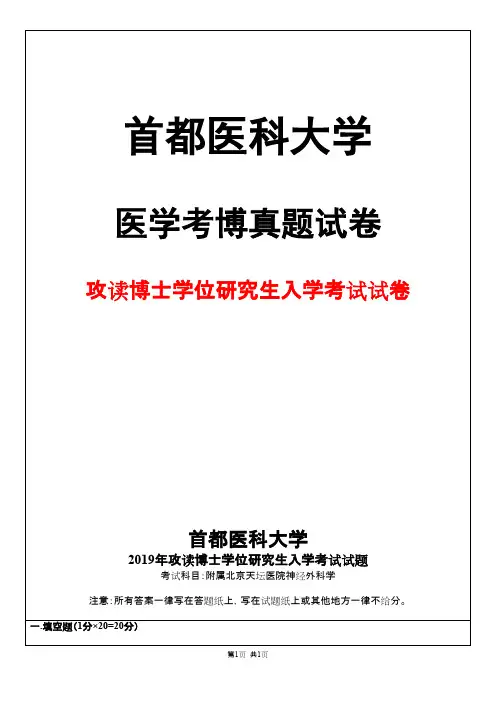
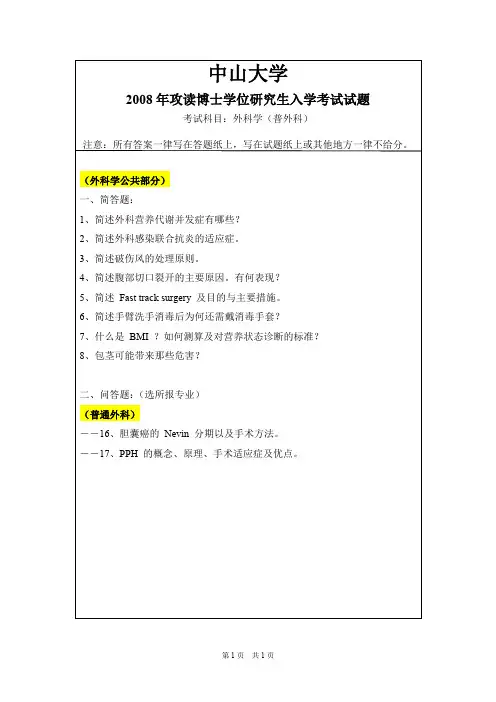
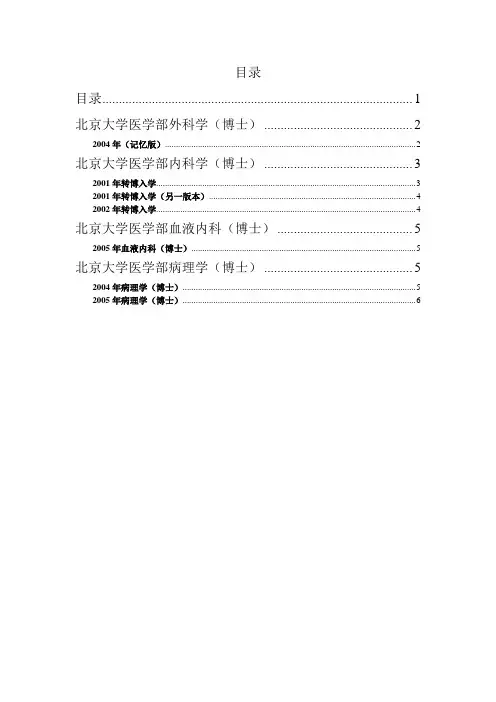
目录目录 (1)北京大学医学部外科学(博士) (2)2004年(记忆版) (2)北京大学医学部内科学(博士) (3)2001年转博入学 (3)2001年转博入学(另一版本) (4)2002年转博入学 (4)北京大学医学部血液内科(博士) (5)2005年血液内科(博士) (5)北京大学医学部病理学(博士) (5)2004年病理学(博士) (5)2005年病理学(博士) (6)北京大学医学部外科学(博士)2004年(记忆版)1剖腹探查的指征2休克3睾丸肿瘤的化疗方案4有关肾上腺肿瘤的一些问题5顺应性北京大学医学部生物化学(博士)2000年1.名词解释1.chemical shift 2 .florescence anisotropy 3.spin labelling 4.dichroicratio 5.relaxation time 6.lipidpolymorphism 7.phase separation 8.active oxygen 9.secondary structure10.sensitized fluorescence 11.adtivc transport 12.ion pump 13.ion channel 14.patch clamp 15.ceii adhesion 16.free radical 17.modeling 18.feedback19.biocybernetics rmation processing二.问答题1.举出一种研究生物膜上脂质分子排列有序程度的方法,栀要说明其原理2.说明维持蛋白质二级结构的力的特点.3.栀要说明红外光谱再研究生物分子结构中应用.4.解释脂双层发生相变的分子机理5.机体中离子地细胞内、外浓度不同,是什么因素决定的?细胞如何利用这种差别作功?6.简述影响细胞粘着的因素?7.细胞内钙浓度增加的主要原因有那些?8.膜片箱技术的用途是什么?有何优点?9.什么是线性系统和非现性系统?其主要的不同特征是什么?10.体内稳态系统主要是靠什么控制环节来保持系统稳态特征的?2002年1.人类基因组的概念,内容和意义。
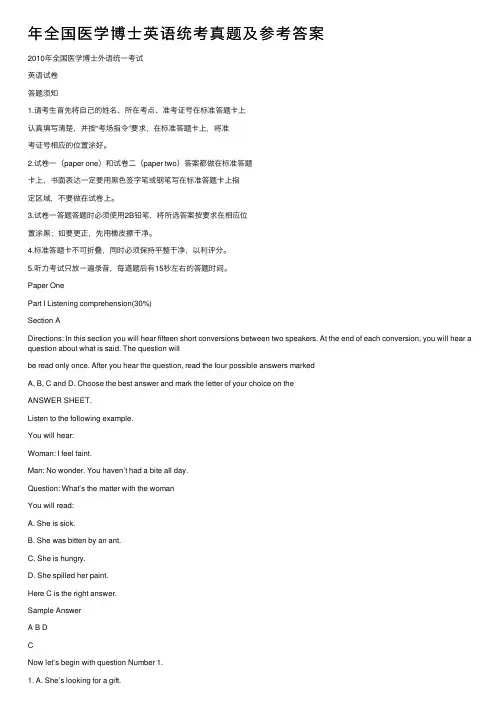
年全国医学博⼠英语统考真题及参考答案2010年全国医学博⼠外语统⼀考试英语试卷答题须知1.请考⽣⾸先将⾃⼰的姓名、所在考点、准考证号在标准答题卡上认真填写清楚,并按“考场指令”要求,在标准答题卡上,将准考证号相应的位置涂好。
2.试卷⼀(paper one)和试卷⼆(paper two)答案都做在标准答题卡上,书⾯表达⼀定要⽤⿊⾊签字笔或钢笔写在标准答题卡上指定区域,不要做在试卷上。
3.试卷⼀答题答题时必须使⽤2B铅笔,将所选答案按要求在相应位置涂⿊;如要更正,先⽤橡⽪擦⼲净。
4.标准答题卡不可折叠,同时必须保持平整⼲净,以利评分。
5.听⼒考试只放⼀遍录⾳,每道题后有15秒左右的答题时间。
Paper OnePart I Listening comprehension(30%)Section ADirections: In this section you will hear fifteen short conversions between two speakers. At the end of each conversion, you will hear a question about what is said. The question willbe read only once. After you hear the question, read the four possible answers markedA, B, C and D. Choose the best answer and mark the letter of your choice on theANSWER SHEET.Listen to the following example.You will hear:Woman: I feel faint.Man: No wonder. You haven’t had a bite all day.Question: What’s the matter with the womanYou will read:A. She is sick.B. She was bitten by an ant.C. She is hungry.D. She spilled her paint.Here C is the right answer.Sample AnswerA B DCB. She needs a new purse.C. She’s going to give a birthday party.D. She wants to go shopping with her mom.2. A. She hears noises in her ears day and night.B. She has been overworking for a long time.C. Her right ear, hurt in an accident, is troubling her.D. Her ear rings are giving her trouble day and night.3. A. He’ll go to see Mr. White at 10:30 tomorrow.B. He’d like to make an earlier appointment.C. He’d like to cancel the appointment.D. He’d like to see another dentist.4. A. 8:00 B. 8:15 C. 8:40 D. 8:455. A. In a hotel. B. At a fast food bar.C. In the supermarket.D. In the department store.6. A. To resign right away.B.To work one more day as chairman.C.To think twice before he make the decision.D.To receive further training upon his resignation.7. A. She didn’t do anything in particular.B.She send a wounded person to the ER.C.She had to work in the ER.D.She went skiing.8. A. A customs officer. B. The man’s mother.C. A school headmaster.D. An immigration officer.9. A. It feels as if the room is going around.B.It feels like a kind of unsteadiness.C.It feels as if she is falling down.D.It feels as if she is going around.10. A. John has hidden something in the tree.B.John himself should be blamed.C.John has a dog that barks a lot.D.John is unlucky.11. A. The chemistry homework is difficult.B.The chemistry homework is fun.C.The math homework is difficult.12. A. His backache. B. His broken leg.C. His skin problem.D. His eye condition.13. A. Whooping cough, smallpox and measles.B.Whooping cough, chickenpox and measles.C.Whooping cough, smallpox and German measles.D.Whooping cough, chickenpox and German measles.14. A. Saturday morning. B. Saturday night.C. Saturday afternoon.D. Next weekend.15. A. He’s lost his notebook.B.His handwriting is messy.C.He’ll miss class latter this week.D.He cannot make it for his appointment.Section BDirections: In this section you will hear one conversion and two passages, after each of which, you will hear five questions. After each question, read the four possible answers marked A,B, C and D. Choose the best answer and mark the letter of your choice on theANSWER SHEET.Conversation16. A. He is having a physical checkup.B.He has just undergone an operation.C.He has just recovered from an illness.D.He will be discharged from the hospital this afternoon.17. A. He got an infection in the lungs.B.He had his gallbladder inflamed.C.He was suffering from influenza.D.He had developed a big kidney tone.18. A. A lot better. B. Terribly awful.C. Couldn’t be better.D. Okay, but a bit weak.19. A. To be confined to a wheelchair.B.To stay indoors for a complete recovery.C.To stay in bed and drink a lot of water.D.To move about and enjoy the sunshine.20. A. From 4 pm to 6 pm. B. From 5 pm to 7 pm.C. From 6 pm to 8 pm.Passage One21. A. The link between weight loss and sleep deprivation.B.The link between weight gain and sleep deprivation.C.The link between weight loss and physical exercise.D.The link between weight gain and physical exercise.22. A. More than 68,000. B. More than 60,800.C. More than 60,080.D. More than 60,008.23. A. Sever-hour sleepers gained more weight over time than 5-hour ones.B.Five-hour sleepers gained more weight over time than 7-hour ones.C.Short-sleepers were 15% more likely to become obese.D.Short-sleepers consumed fewer calories than long sleepers.24. A. Overeating among the sleep-deprived.B.Little exercise among the sleep-deprived.C.Lower metabolic rate resulting from less sleep.D.Higher metabolic rate resulting from less sleep.25. A. Exercise every day. B. Take diet pills.C. Go on a diet.D. Sleep more.Passage Two26. A. She is too hard on me.B.She asks too many questions.C.She is always considerate of my feelings.D.She is the meanest mother in the neighborhood.27. A. A university instructor. B. A teaching assistant.C. A phD student.D. A psychiatrist.28. A. They usually say no.B.They usually say yes.C.They usually wait and see.D.They usually refuse to say anything.29. A. They are overconfident.B.Their brains grow too fast.C.They are psychologically dependent.D.Their brains are still immature in some areas.30. A. Be easy on your teen.B.Try to be mean to your teen.D.Don’t care about your teen’s feelings.Part II Vocabulary (10%)Section ADirections: In this section all the statements are incomplete, beneath each of which are four words or phrases marked A, B, C and D. Choose the word or phrase that can bestcomplete the statement and mark the letter of your choice on the ANSWERSHEET.31. A number of black youths have complained of being by the police.A. harassedB. distractedC. sentencedD. released32. He rapidly became with his own power in the team.A. irrigatedB. irradiatedC. streetlightD. torchlight33. Throughout his political career he has always been in the .A. twilightB. spotlightC. streetlightD. torchlight34. We that diet is related to most types of cancer but we don’t have definite proof.A. suspendB. superveneC. superviseD. suspect35. A patient who is dying of incurable cancer of the throat is in terrible pain, which can nolonger be satisfactorily .A. alleviatedB. abolishedC. demolishedD. diminished36. The television station is supported by from foundations and other sources.A. donationsB. pensionsC. advertisements37. More legislation is needed to protect the property rights of the patent.A. integrativeB. intellectualC. intelligent38. Officials are supposed to themselves to the welfare and health of the generalpublic.A. adaptB. confineC. commitD. assess39. You should stop your condition and do something about it.A. drawing onB. touching onC. leaning onD. dwelling on40. The author of the book has shown his remarkably keen into human nature.A. perspectiveB. dimensionC. insightD. reflectionSection BDirections: In this section each of the following sentences has a word or phrase underlined, beneath which are four words or phrase. Choose the word or phrase which canbest keep the meaning of the original sentence if it is substituted for theunderlined part. Then mark the letter of your choice on the ANSWER SHEET.41.The chemical was found to be detrimental to human health.A. toxicB. immuneC. sensitiveD. allergic42.It will be a devastating blow for the patient, if the clinic closes.A. permanentB. desperateC. destructiveD. sudden43.He kept telling us about his operation in the most graphic detail.A. verifiableC. preciseD. ambiguous44.The difficult case tested the ingenuity of even the most skillful physician.A. credibilityB. commitmentC. honestyD. talent45.He left immediately on the pretext that he had to catch a train.A. claimB. clueC. excuseD. talent46.The nurse was filled with remorse of not believing her .A. anguishB. regretC. apologyD. grief47.The doctor tried to find a tactful way of telling her the truth.A. delicateB. communicativeC. skillfulD. considerate48.Whether a person likes a routine office job or not depends largely on temperament.A. dispositionB. qualificationC. temptationD. endorsement49.The doctor ruled out Friday’s surgery for the patient’s unexpected complications.A. confirmedB. facilitatedC. postponedD. cancelled50.It is not easy to remain tranquil when events suddenly change your life.A. cautiousB. motionlessC. calmD. alertDirections: In this section there is a passage with ten numbered blanks. For each blank, there are four choice marked A, B, C and D listed on the right side. Choose the best answer andmark the letter of your choice on the ANSWER SHEET.Experts say about 1% of young women in the United States are almost starving themselves today. They are suffering from a sickness called anorexia.These young women have an abnormal fear of getting fat. They 51 starve themselves so they weigh at 15% less than their normal weight.The National Institute of Mental Health says one 52 ten cases of anorexia leads to serious medical problems. These patients can die from heart failure or the disease can lead young womento 53 themselves. For example, former gymnast Christy Henrich died at age 22. She weighed only61 pounds.A person with anorexia first develops joint and muscle problems. There is a lack of iron inthe blood. 54 the sickness progresses, a young woman’s breathing, heartbeat, and blood pressure rates slow down. The important substance calcium is 55 from the bones, something causing bones to break. Sometimes the brain gets smaller, causing changes in 56 a person thinks and acts. Scientists say many patients have further mental and emotional problems. They have 57 opinions about themselves. They feel helpless. Their attempts to become extremely thin may 58 efforts to take control of their lives. They may become dependent on illegal drugs. Some people also feel the need to continually repeat a(n) 59 . For example, they may repeatedly wash their hands although their hands are clean.Anorexia is a serious eating 60 .If it is not treated on time, it can be fatal.51. A. specifically B. purposely C. particularly D. passionately52. A. from B. of C. at D. in53. A. kill B. starve C. abuse D. worsen54. A. When B. While C. As D. Since55. A. lost B. derived C. generated D. synthesized56. A. what B. why C. how D. which57. A. good B. high C. lower D. poor58. A. represent B. make C. present D. exert59. A. medication B. illusion C. motion D. action60. A. habit B. behavior C. disorder D. patternPart IV Reading Comprehension(30%)Direction:In this part there are six passages, each of which is followed by five questions. For each question there are four possible answers marked A, B, C and D. Choose the bestanswer and mark the letter of your choice on the ANSWER SHEET.Passage OneChildren should avoid using mobile phones for all but essential calls because of possible health effects on young brains. This is one of the expected conclusions of an official government report to be published this week. The report is expected to call for the mobile phone industry to refrain from promoting phone use by children, and to start labeling phones with data on the amount of radiation they emit. The Independent Expert Group on Mobile Phones, chaired by former government chief scientist William Stewart, has spent eight months reviewing existing scientific evidence on all aspects of the health effects of using mobile phones. Its report is believed to conclude that because we don’t fully understand the nonthermal effects of radiation on human tissue, the government should adopt a precautionary approach, particularly in relation to children.There is currently no evidence that mobile phones harm users or people living near transmitter masts. But some studies show that cell-phones operating at radiation levels within current safety limits do have some sort of biological effect on the brain.to environmental insults,” he says,“So if phones did prove to be hazardous——which they haven’t yet ——it would be sensible.”In 1998, Tattersall showed that radiation levels similar to those emitted by mobile phones could alter signals from brain cells in slices of rat brain, “What we’ve found is an effect, but we don’t know if it’s hazardous,” he says.Alan Preece of the University of Bristol, who found last year that microwaves increase reaction times in test subjects, agreed that children’s exposure would be greater. “There’s a lot less tissue in the way, and the skill is thinner, so children’s heads are considerably closer,” he says.Stewart’s report is likely to recommend that the current British safety standards on energy emissions from cell-phones should be cut to the level recommended by the International Commission on Non-Ionizing Radiation Protection, which is one-fifth of the current British limit. “The extra safety factor of five is somewhat arbitrary,” s ays Michael Clark of the National Radiological Protection Board. “But we accept that it’s difficult for the UK to have different standards from an international body.”61. Just because it has not been confirmed yet whether mobile phone emissions can harm humantissue, according to the government report, does not mean that .A. the government should prohibit children from using cell-phonesB. we should put down the phone for the sake of safetyC. the industry can have a right to promote phone useD. children are safe using cell-phones62. Tattersall argues that it is wise to refrain mobile phone use by children in termsof .A. their neural developmentB. their ill-designed cell-phonesC. the frequency of their irrational useD. their ignorance of its possible health effects63. On the issue in question, Preece .A. does not agree with TattersallB. tries to remove the obstacles in the wayC. asks for further investigationD. would stand by Stewart64. What is worrisome at present is that the UK .A. is going to turn deaf ears to the voice of Stesart’s planB. finds it difficult to cut the current safety standards on phone useC. maintains different standards on safety limit from the international onesD. does not even impose safety limit on the mobile phones’ energy emissions65.Which of the following can bi the best candidate for the title of the passageA . Brain Wave B. For Adults OnlyC. Catch Them YoungD. The Answer in the AirPassage TwoAdvances in cosmetic dentistry and plastic surgery have made it possible to correct facial birth defects, repair damaged teeth and tissue, and prevent or greatly delay the onset of tooth decay and gum disease. As a result, more people smile more often and more openly today than ever in the past, and we can expect more smiles in the future.middle-class family members in formal portraits and domestic scenes appear to have their mouths firmly closed. Soldiers in battle, children at play, beggars, old people, and especially villains may have their mouths open; but their smiles are seldom attractive, and more often suggest strain or violence than joy.Smiles convey a wide range of meanings in different eras and cultures, says art historian Angus Trumble, currently curator(馆长)of Yale University’s Center for British Art, in his book A Brief History of the Smile. Compare, for instance, the varying impressions made by the shy dimples(酒窝)of Leonardo’s Mona Lisa; the rosy-cheeked, mustachioed Laughing Cavalier of Frans Hals; and the”Smiley Face”logo perfected(though not invented)in 1963 by American graphic artist Harvey .In some non-Western cultures, Trumble notes, even a warm, open smile does not necessarily indicate pleasure or agreement. It can simply be a polite mask to cover emotions considered too rude or shocking to bi openly displayed.Subtle differences in muscle movement can convey enormous differences in emotion, from the tranquility of bronze Buddhas, to the erotic bliss of couples entwined in stone on Hindu temples,to the fierce smirk(假笑)of a guardian demon at the entrance to a Chinese tomb.Trumble expects the impact of Western medicine and mass media to further increase the pressure on people to grin broadly and laugh openly in public.”Faint smiles are increasingly thought of in scientific and psychological circles as something that falls short of the true smile ,”and therefore suggest insincerity or lack of enthusiasm, he says.With tattooing, boby piercing, and permanent cosmetics already well established as fashion trends, one can imagine tomorrow’s beauty shops adding plastic surgeons and dentists to their staffs. These comer-store cosmeticians would offer style makeovers to reshape our lips, teeth, and jawlines to mimic the signature smile of one’s favorite celebrity.What can you say to that except” Have a nice day”66. Had it not been for cosmetic advances, as inferred from the passage, .A . people would not have been as happy as they are todayB. the rate of facial birth defect would not have declinedC . there would not have been many more open smilesD. we would not have seen smiling faces in public67. According to the passage, it seems that whether there is a smile or not in the portraits orpictures is decided by .A. one’s internal sense of the external worldB . one’s identity or social positionC . one’s times of existenceD . All of the above68. Trumble’s study on smiles shows that .A. an open smile can serve as a cover-upB . the famous portraits radiate varying smilesC. even the human muscles can arouse varying emotionsD. smiles can represent misinterpretations of different eras and cultures69. What Trumble expects to see is .A. the increasing tendency of broad grins and open smiles in publicB . further impact of Western medicine upon non-Western culturesC. a wider range of meanings to be conveyed by smilesD. more of sincerity and enthusiasm in public70 . At the end of the passage, the author implicates .C . future changes in life styleD . the future of smilesPassage ThreeAdolf Hitler survived an assassination attempt in 1944 with the lamp of penicillin made by the Allies, a microbiologist in the UK claims. If the Nazi leader had died from bacterial infection ofhis many wounds, the Second World War might have been over a year earlier, saving millions of lives, says Milton Wainwright of the University of Sheffield, a noted historian of microbiology.In a paper to be published soon in Perspectives in Biology and Medicine, Wainwright reveals first-hand evidence that Hitler was treated with penicillin by his personal doctor, Theo Morrell, following an assassination attempt in which a bomb in a suitcase exploded next to Hitler’s desk. Hitler was badly hurt, fleeing the scene with his hair and trousers on fire, a badly bleeding arm and countless wooden splinter wounds from the oak table that probably saved his life.Wainwright found confirmation that Morrell gave Hitler antibiotics as a precaution in a recent translation of Morrell’s own diary. “I happened to be reading it for interest when the word penicillin jumped out at me,” he says. He then set about trying to establish where Morrell might have got the drug.At the time, penicillin was available only to the Allies. German and Czechoslovakian teams had tried without much success to make it, Wainwright says, but the small quantities that weresays Wainwright. available were weak and impure. “It’s generally accepted that it was no good,”He reasons that Morrell would only have risked giving Hitler penicillin to prevent infectionsif he were confident that the antibiotic would cure, not kill the German premier. “My research shows that Morrell, in a very dodgy(危险的) position as Hitler’s doctor, would only have used pure stuff.” And the only reliable penicillin was that made by the Allies. So where did Morrell getitWainwright’s investigations revealed that Allied airmen carried penicillin, so the Germans may have confiscated some from prisoners of war. The other more likely source is from neutral countries such Spain, which received penicillin from Allied countries for humanitarian purposes, perhaps for treating sick children.have proof the Allies were sending it to these countries,” says Wainwright. “I’m saying “Ithis would have got through in diplomatic bags, reaching Hitler’s doctor and the higher echelons(阶层)of the Nazi party. So this was almost certainly pure, Allied penicillin.”“We can never be certain it saved Hitler’s life,” says Wainwright. But he notes that one of Hitler’s henchmen(死党),Reinhard Heydrich, died from blood poisoning after surviving acar-bomb assassination attempt. “Hair from his seat went into his wounds and gave him septicemia,” says Wainwright. Morrell may have been anxious to ensure that Hitler avoided the same fate.71. According to Wainwright, Adolf Hitler .A. might have used biological weapons in the warB. could not have committed suicide as confirmedC. could have died of bacterial infectionD. might have survived a bacterial plague72. Following his assassination in 1944, Adolf Hitler .A. began to exercise precautions against his personal attacksB. was anxious to have penicillin developed in his countryC. received an jinjection of penicillin for blood poisoningD. was suspected of being likely to get infecteds personal doctor .73. As Wainwright reasons, H itler’A. cannot have dared to prescribe German-made penicillin to himB. need not have used pure antibiotic for his suspect infectionC. would have had every reason to assassinate himD. must have tried to produce penicillin74. Wainwright implies that the Third Reich .A. met the fate of collapse as expectedB. butchered millions of lives on the earthC. was severely struck by bacterial plaguesD. did have channels to obtain pure penicillin75.Which of the following can be the best title for the passageA.How Hitler Manage to Survive Assassination AttemptsB.Morrell Loyal to His German PrimierC.Hitler Saved by Allied DrugsD.Penicillin Abused in GermanPassage FourGet ready for a new kind of machine at your local gym: one that doesn’t involve huffing and puffing as you burn off calories. Instead, all you have to do is stand still for 30 seconds while the machine measures your body fat. It could then tell you exactly where you could do with losing afew pounds and even advise you on exercises for your problem areas. If the body fat scanner turns out to be accurate enough, its makers hope it could one day help doctors spot disease.The scanner works by simultaneously building up an accurate 3D image of the body, while measuring the body’s effect on an electromagnetic field. Combining the two measurements allows the researchers to work out the distribution of fat and water within. Neither method is new on itsown, says Henri Tapp, at the Institute of Food Research in Norwich in the UK. “The smart thing is that we’ve put them in one machine.”And it’s not just for gym users. The body fat scanner could be used to study fat deposition as children develop, while patients recover from injury, or during pregnancy. And since it uses radio waves rather than X-rays, Tapp’s device is safe to use repeatedly.Body shape is known to be a risk indicator for heart disease and diabetes. So accurately quantifying fat distribution could help doctors suggest preventive measures to patients before problems arise. At the moment, doctors estimate fat content from knowing body volume and water content. To a good approximation, says Tapp, anything that isn’t fat is water. The amount of water in the body is often measured by giving the subject a drink of water that contains a radioactive tracer. The level of tracer in the patient's urine after three hours reveals the total water volume.To find out a body’s volume, subjects are weighed while totally submerged in water, and thisis subtracted from their normal weight to give the weight of water displaced, and hence the subject’s volume. But it is scarcely practical for seriously ill people.There are other ways to directly measure body fat, such as passing a minuscule current between the wrists and feet. The overall fat content can then be estimated from the body’s resistance. But this method doesn’t take body shape into account ——so a subject with particularly skinny legs might register a higher fat content than the true value. That’s because skinny legs—with a lower cross-sectional area——will present higher resistance to current. So the machine thinks the water content of the body is lower——rating the subject as fatter. Also, the system can only give an overall measurement of fat.Tapp’s method uses similar calculations, but is more sophisticated because it tells you where you are piling on the pounds.76. The new machine is designed .A. to picture the body’s hidden fatB. to identify those at risk for obesityC. to help clinically treat specific casesD. to measure accurately risky obesity-related effects77. The beauty of the device, according to Tapp, is that .A. it performs a dual functionB. it is of great accuracy in measurementC. it has significant implications in clinical practiceD. it contributes to the evolution of human anatomy78.Which of the following, according to the passage, does the machine have the potential tospareA. A minuscule current.B. A radioactive tracer.C. A water tank.D. All of the above.79.In comparison with the techniques mentioned in the passage, the body fat scanner .A. quickens the pace of the patient’s rehabilitationB. is highly appreciated for its safetyC. features its measuring precisionD. is easy to operate in the clinic80.For scanning, all the subject has to do is .A. take up a form of workout in the gymB. turn round the body fat scannerC. lie on the electromagnetic fieldD. sand in the systemPassage FiveThere is currently abroad a new wave of appreciation for breadth of knowledge. Curricula at universalities and colleges and programs in federal agencies extol(赞扬) the virtues of a broad education. For scientists who work in specialized jobs, it is a pleasure to escape in our spare timeto read broadly in fields distant from our own. Some of us have made interdisciplinary study our occupation, which is no surprise, because much of the intellectual action in our society today liesat the interfaces between traditional disciplines. Environmental science is a good example, because it frequently requires us to be conversant in several different sciences and even some unscientific fields.Experiencing this breadth of knowledge is stimulating, but so is delving deeply into a subject. Both are wonderful experiences that are complementary practical and aesthetic(美学的)ways. They are like viewing the marvelous sculpture of knowledge in two different ways. Look at the sculpture from one perspective and you see the piece in its entirety, how its components connect to give it form, balance, and symmetry. From another viewpoint you see its detail, depth, and mass. There is no need to choose between these two perspectives in art. To do so would subtract fromthe totality of the figure.So it is with science. Sometimes we gaze through a subject and are reluctant to stop for too much detail. As chemists, we are fascinated by computer sciences or molecular genetics, but not enough to become an expert. Or we may be interested in an analytical technique but not enough to stay at its cutting edge. At other times, we become immersed in the detail of a subject and see its beauty in an entirely different way than when we browse. It is as if we penetrate the surface of the sculpture and pass through the crystal structure to the molecular level where the code for the entire structure is revealed.Unfortunately, in our zeal for breadth or depth, we often feel that it is necessary to diminishthe value of the other. Specialists are sometimes ridiculed with names such as “nerd”or “technocrats”, generalists are often criticized for being too “soft” or knowing too little about any one thing. Both are ludicrous(可笑的) accusations that deny a part of the reality of。